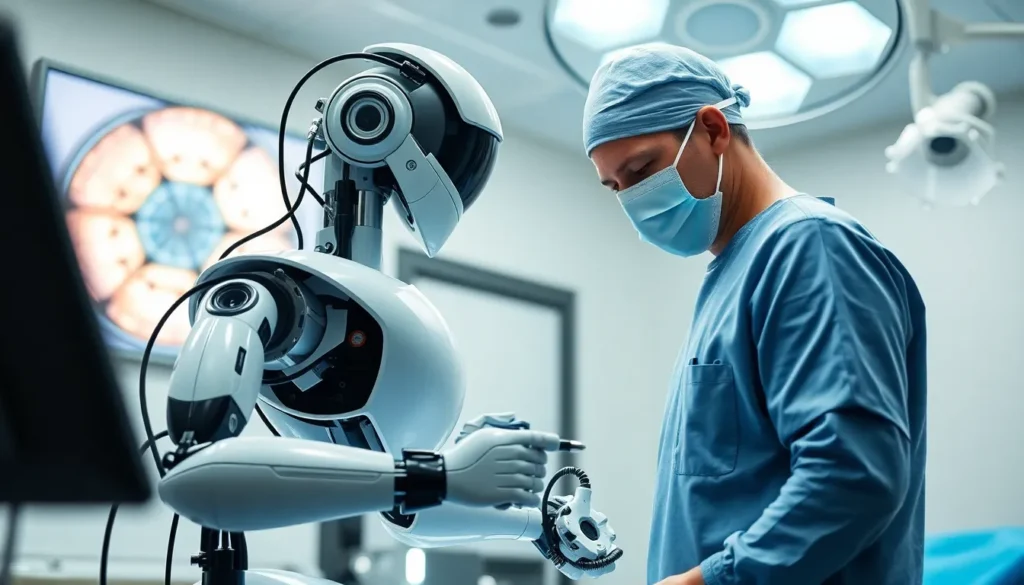In a world where robots are no longer just the stuff of sci-fi movies, neura robotics is leading the charge into a future that’s both exciting and a little bit mind-boggling. Imagine a robot that can learn, adapt, and even understand human emotions. Sounds like something out of a futuristic comedy, right? Yet, this is the reality unfolding before us, and it’s not just about shiny gadgets; it’s about enhancing lives and redefining what machines can do.
Neura robotics is revolutionizing industries from healthcare to manufacturing, making tasks easier and more efficient. These aren’t your run-of-the-mill robots; they’re smart, intuitive, and ready to take on challenges that would make even the most seasoned professionals raise an eyebrow. Dive into the fascinating world of neura robotics and discover how these innovative creations are not just changing the game—they’re rewriting the rules entirely.
Table of Contents
ToggleOverview of Neura Robotics
Neura robotics represents a significant leap in the field of automation. These robots integrate artificial intelligence to enhance learning capabilities. By processing data from their environment, they adapt to new tasks and situations swiftly. Some examples illustrate their versatility, including surgical assistance in healthcare and automation processes in manufacturing.
Robots in this category often utilize advanced machine learning algorithms. These algorithms allow machines to recognize patterns and respond to human emotions. Manufacturers incorporate such technology to create systems that improve workplace efficiency and safety. The emotional intelligence demonstrated by these robots marks a notable shift in human-robot interaction.
Neura robotics also plays a crucial role in rehabilitation therapies. They assist patients in regaining mobility through customized training programs. These robots are programmed to analyze movements, providing real-time feedback for improvement.
Safety protocols enhance interactions, ensuring users feel comfortable and secure. Users report higher satisfaction levels when engaging with emotionally intelligent robots. Examples in real-world applications show that incorporating neura robotics can lead to higher productivity metrics and reduced operational costs.
The ongoing research in this field further propels neura robotics forward. New developments continually refine their capabilities. As industries embrace these advanced systems, the future of work evolves, maximizing human potential alongside robotic innovation.
Applications of Neura Robotics

Neura robotics is making significant strides across multiple fields, reshaping how industries operate. Here are key applications of these innovative robots.
Industrial Automation
Neura robotics optimizes production lines through real-time monitoring and adjustment. They perform repetitive tasks with precision, ensuring high efficiency in manufacturing processes. Factories equipped with neura robots reduce downtime while enhancing productivity significantly. These intelligent systems learn from data, adapting to changing environments and workflows. Their use of predictive maintenance minimizes equipment failures, ultimately lowering operational costs.
Healthcare Innovations
In healthcare, neura robots support surgical procedures and patient recovery. These robots assist surgeons with precise movements, increasing the accuracy of complex operations. They also aid rehabilitation by offering customized therapy sessions tailored to individual needs. Equipped with feedback systems, neura robots provide real-time guidance during exercises, helping patients progress effectively. The integration of AI allows these robots to understand and respond to patients’ emotional cues, enhancing patient experience and satisfaction.
Personal Assistants
Neura robotics enhances personal life through everyday assistance. Home assistant robots manage tasks like cleaning, cooking, and scheduling, making life more efficient. They adapt to personal preferences, offering customized interactions. By understanding verbal commands and contextual clues, these robots streamline household activities. Their ability to learn from user habits results in greater convenience and enhanced quality of life.
Technology Behind Neura Robotics
Neura robotics incorporates advanced technologies that enable these intelligent machines to excel across various applications.
Artificial Intelligence Integration
Artificial intelligence drives the core functions of neura robotics. Machine learning algorithms allow robots to analyze data and improve performance over time. These algorithms enhance the robots’ ability to recognize patterns and make informed decisions. Natural language processing enables seamless interaction with humans, facilitating better communication. Moreover, deep learning models improve their understanding of human emotions and reactions, which leads to more empathetic responses. Ultimately, the integration of AI transforms these machines into smart assistants capable of adaptive learning and mobile responsiveness.
Sensor Technologies
Sensor technologies play a crucial role in the functionality of neura robotics. Advanced sensors enable robots to perceive and interact with their environment effectively. Proximity sensors allow robots to navigate spaces without collisions while maintaining safety. Cameras assist in visual recognition, aiding in both complex tasks and simple interactions. Force and tactile sensors provide feedback, ensuring precision in movements, particularly in healthcare settings. Together, these sensors facilitate real-time monitoring and feedback, enhancing the robots’ ability to function autonomously while performing intricate tasks reliably.
Benefits of Neura Robotics
Neura robotics offer significant advantages across various sectors. These intelligent machines enhance operations in healthcare, manufacturing, and everyday life.
Increased Efficiency
Neura robotics streamline production processes, allowing companies to boost output. Tasks that are repetitive are executed with precision, resulting in time savings. Advanced algorithms facilitate real-time monitoring, adapting to changes quickly. For instance, robots can adjust workflows instantly based on demand fluctuations. Productivity increases notably, with data indicating up to a 30% improvement in certain environments. Real-time analysis enables optimal performance, allowing human workers to focus on complex tasks.
Improved Safety
Safety significantly improves with the integration of neura robotics. Robots perform high-risk tasks, reducing the likelihood of human injury. By taking over dangerous activities, they minimize accident rates in workplaces. Neura robots also utilize advanced sensors to detect hazards, responding promptly to keep environments safe. A study shows that facilities using these robots experience up to a 50% reduction in workplace injuries. Adapting to emergency situations, they enhance overall workplace safety protocols.
Enhanced User Experience
Enhanced user experience is another key benefit of neura robotics. These machines learn and adapt to individual preferences, personalizing interactions. Home assistant robots help manage daily tasks, from scheduling to cleaning, making life easier. Users appreciate the ability of robots to understand verbal commands, allowing for fluid communication. Responding to habits leads to a tailored experience never seen with traditional robots. Research highlights that households using these assistants report a 40% increase in satisfaction with everyday task management. Overall, neura robotics foster convenience and elevate daily living standards.
Future Trends in Neura Robotics
Advancements in neura robotics are set to revolutionize various sectors even further. Enhanced adaptability remains a focal point, with robots expected to demonstrate more refined learning processes. Increased integration of machine learning could lead to improved autonomy in dynamic environments, allowing robots to perform complex tasks without direct human intervention.
Collaboration between humans and robots will grow stronger through natural language processing advancements. Seamless communication will enable more effective teamwork, facilitating cooperative tasks across industries. Improved emotional recognition capabilities will further enhance interactions, making robots more responsive to human needs.
Another significant trend involves the use of advanced sensor technologies. Proximity sensors, cameras, and tactile feedback systems are anticipated to evolve, enhancing robots’ ability to navigate diverse environments. Enhanced perception will allow robots to adapt in real time, improving safety and performance levels during operation.
Predictive analytics in neura robotics plays a crucial role in decision-making processes. With the ability to analyze vast amounts of data, robots will anticipate maintenance needs and optimize workflow efficiency. These predictive capabilities can result in reduced operational costs, benefiting both manufacturers and service providers.
In the home, personal assistant robots will likely increase in prevalence. With improved customization features, these robots can tailor their functionalities to meet individual preferences seamlessly. Data suggests that households using these technologies experience a 40% improvement in user satisfaction, highlighting the significant impact of personal robotics on daily life.
Overall, the future of neura robotics promises a transformative effect across industries, emphasizing efficiency and enhanced human-machine collaboration. As technology continues to evolve, the capacity of these intelligent machines to enrich human experiences and streamline operations remains paramount.
Neura robotics stands at the forefront of technological innovation, reshaping industries and enhancing daily life. Their ability to learn and adapt makes them invaluable assets in both healthcare and manufacturing. As these robots continue to evolve, their integration of artificial intelligence and machine learning will further improve efficiency and safety.
The future is bright for neura robotics, with advancements in emotional recognition and natural language processing paving the way for deeper collaboration between humans and machines. This evolution not only promises to streamline operations but also enriches user experiences, making life easier and more efficient. Embracing this technology will undoubtedly lead to a transformative impact across various sectors.










